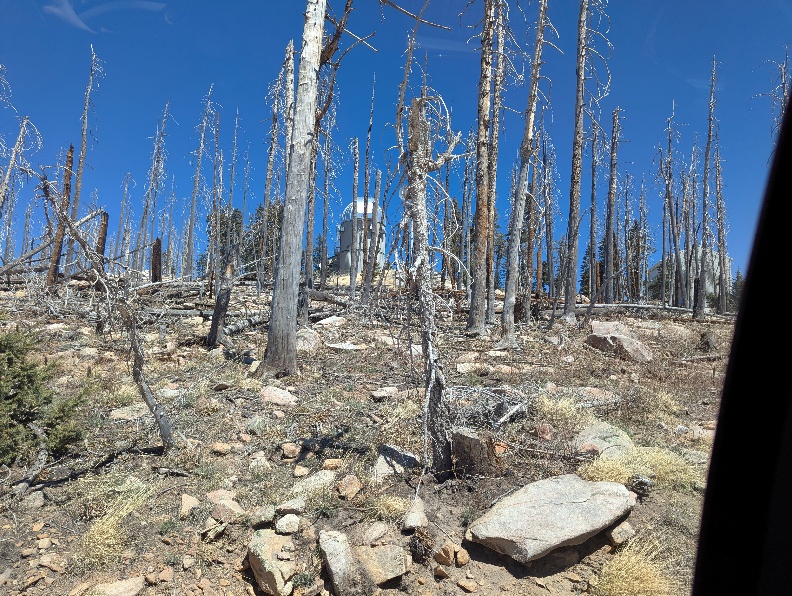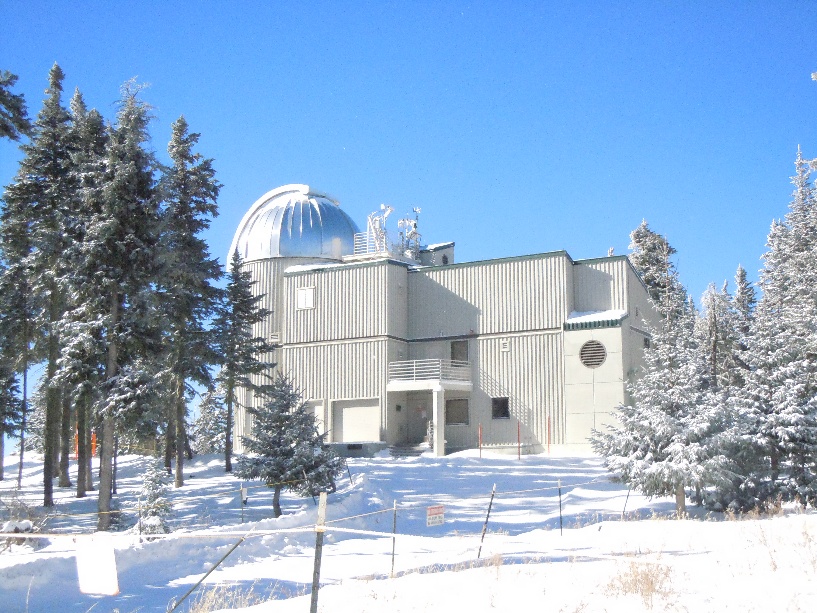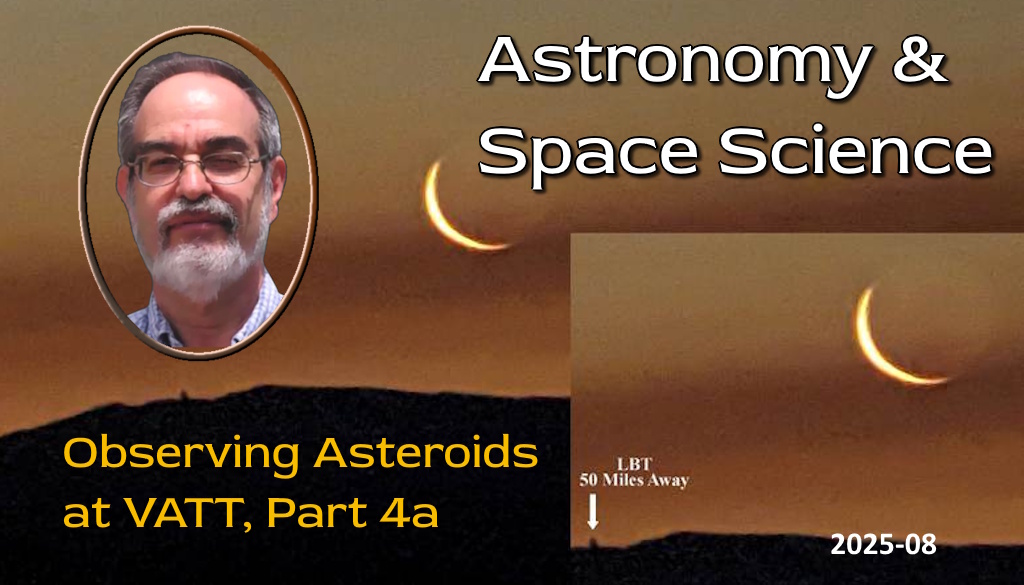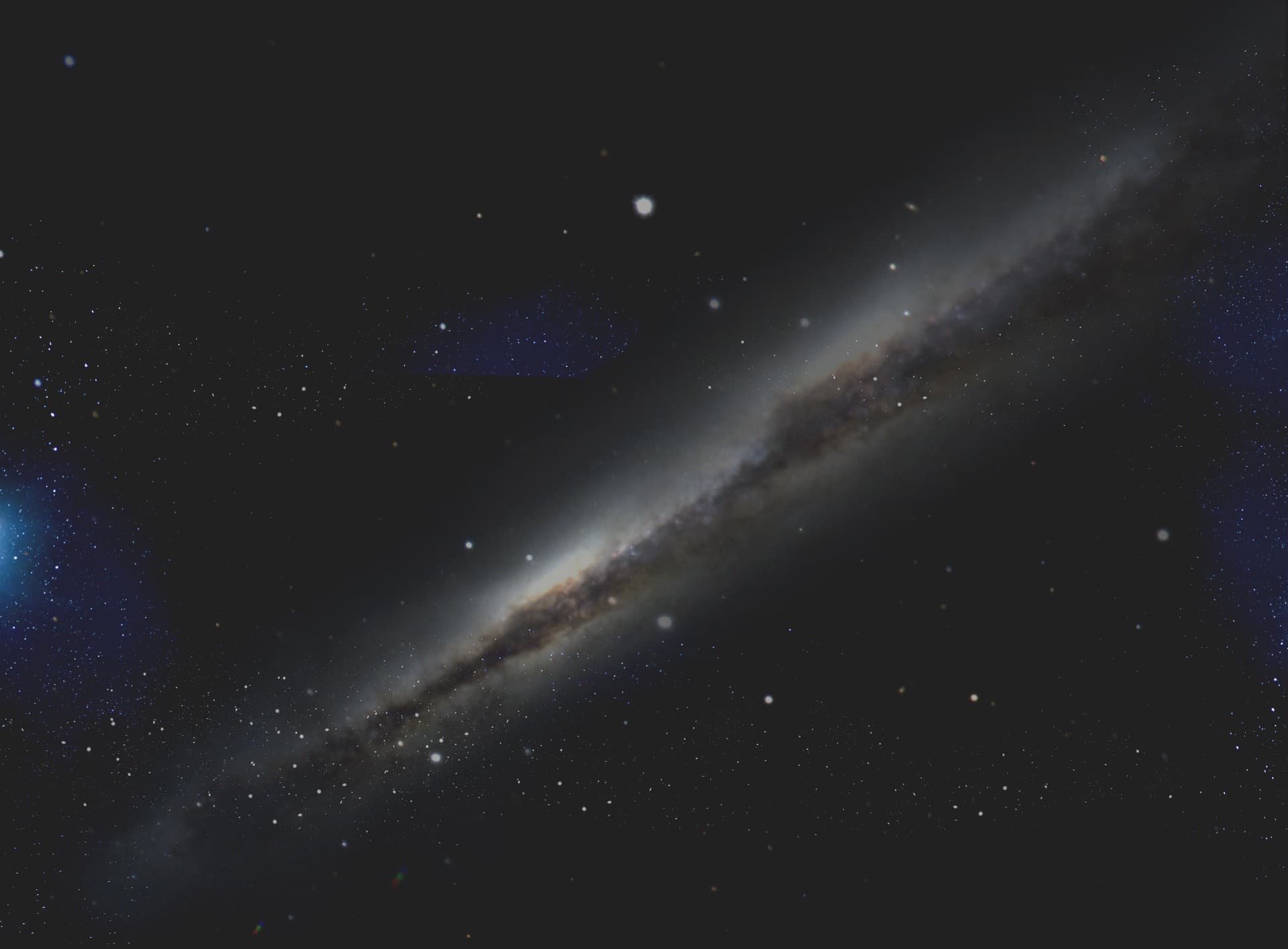Back at VATT, an Update: Protecting the Earth from “The Big One”
Introduction
This article will be in two parts. The first part includes some background about the VATT, a typical trip to the VATT on Mt. Graham, and an astronomy lesson related to the trip. The second part will describe the science that we have accomplished on the VATT in the 10 years that my team and I have been observing on the VATT.

Image 1: Mt. Graham and the Large Binocular Telescope (LBT) from the top of Mt. Lemmon, a little over 80 km (50 miles) away (just before dawn). The Vatican Advanced Technology Telescope (VATT) is a little to the right of the LBT, hidden by trees and the mountain. Behind me is the main telescope of the Catalina Sky Survey, which continues to be the most successful discoverer of Near-Earth Objects. (Credit: Larry Lebofsky)
Back to VATT Again
This is a time for celebration for our observing team. Since 2015, we have observed over 120 Near Earth Objects1 on the Vatican Advanced Technology Telescope. In 2019 and 2020, I wrote two articles about our Near-Earth Object observing programs, “Citizen Science, Observing on the Vatican Advanced Technology Telescope: Citizen Science from Two Miles Up” and “Observing Asteroids at VATT, Part 2.”
In the 2020 article, I wrote about our new program, observing within three or four days of Full Moon, what astronomers call “bright time” (lunar light pollution). You can see this for yourself. Go out some evening after it gets dark, around Full Moon. See how hard it is to identify constellations and the fainter stars. Then, go out a week or two later, before the Moon rises and see how many more stars you can see.
Typically, at the telescope, we lose about a magnitude of sensitivity (a factor of 2.5 in brightness) when the Moon is up and it is near Full Moon. Because of this, about a third or more of our target asteroids are too faint to observe. Many observatories, including the asteroid surveys, will take a few days off, creating a gap of as much as a week before and after Full Moon where few newly discovered Near Earth Objects are observed. We proposed to fill that gap. Unfortunately, just as we started the program, COVID closed the observatories down and we could not observe for nearly two years. Finally, at the end of 2021, we were able to observe again.
Here is a description of the Mount Graham International Observatory that I had in the Citizen Science article:
“Mt. Graham is located about 125 miles east [by road] and a little north of Tucson, AZ, where I live. Mt. Graham is home to the Mount Graham International Observatory’s (MGIO) three telescopes as well as the endangered Mt. Graham red squirrel. The three telescopes on Mt. Graham include the Heinrich Hertz Submillimeter Telescope (SMT), the Large Binocular Telescope (LBT), and the Vatican Advanced Technology Telescope (VATT). Yes, the Vatican has a telescope in Arizona at an altitude of 10,425 ft., just under 2 miles up! The VATT has a 1.8-meter diameter mirror which was the first mirror spun and polished at the University of Arizona’s Mirror Lab. For the professional astronomical community who has access to telescopes with mirrors 3 or more meters in diameter all over the world, this is not a large telescope. But to the amateur with his backyard telescope, this is a large telescope.”
In July of 2024, I wrote an article about the new operating system for the VATT, a critical upgrade that is needed to be able to operate the VATT remotely (once we get a new camera),“Back to the VATT.”
The Typical Trip to the Observatory
From Tucson, it takes me about five hours for the 210-mile trip. I drive to Sonoita, AZ (60 miles southeast of Tucson) to meet up with Mark Trueblood and Robert Crawford. Mark has a four-wheel-drive truck and snow chains if they are needed. The first view of the observatories (the Large Binocular Telescope) on Mt. Graham is from Wilcox, AZ on I-10, about 40 miles from the Mt. Graham International Observatory basecamp.

At the basecamp, you must check in, pick up a 2-way radio, and a gate key. Since we arrive at the basecamp around noon, we also eat our lunch here before heading up the mountain. The 28-mile drive takes a little over an hour. In winter, the drive may take a little longer if we have to stop to put on chains. A few years ago, we were somewhat delayed when a local hitchhiker decided it wanted to tag along with us.
Once a year, all observers must sign a statement to promise to stay within the boundaries of the Mt. Graham International Observatory site. The observatory site is situated in the middle of a 1,700-acre critical habitat zone, to protect the endangered Mt. Graham Red Squirrels. There is now an estimated population of about 230 red squirrels in the protected area. Many squirrels were lost (down to an estimated 35 squirrels) in the lightning-caused Frye Fire in 2017 that burned over 48,000 acres and came close to destroying the three telescopes on Mt. Graham.

Image 3: Mt. Graham Red Squirrel. (Credit: Paul Young on the Mt. Graham Observatory Site)
Frye Fire VATT Damage Assessment
Here are some images that were in an article posted in June 2017 by Rev. Paul Gabor.

Images 4 and 5: The Frye fire. Left: The conflagration to the south of the MGIO site on Mt. Graham: June 2017. VATT and microwave communications tower in upper right. Right: View from the southwest balcony off the VATT’s control room towards the south-southeast. An intense blaze devastated the trees as close as 50 ft from the foot of our building. In this picture, you can see a string that marks the start of the protected area beyond the telescopes. (Credit: Rev. Paul Gabor)
Editor: Click here to view a map of the Frye fire from wildfire.gov – the VATT is located in the top-right of block 33.
Several miles before you get to the top, you get one quick view of the Large Binocular Telescope (LBT).

Images 6a and 6b: Left: First view of the Large Binocular Telescope, approaching the summit road. Right: Enlarged image. (Credit: Larry Lebofsky)
For the last two miles, you are on a one-lane road, so you need to be in radio contact to make sure no one is coming down when you are going up!
An Astronomy Lesson:
As I mentioned in my first article about Citizen Science, “You know that you are approaching an astronomical observatory because there are markers (for emergencies) at the access road’s switchbacks that are named for the brightest stars in the Pleiades.” Here is a montage of the nine signs.

Image 7: The nine switchback signs on the one-lane road. The last picture shows the SubMillimeter Telescope, SMT. (Credit: Larry Lebofsky)
An interesting piece of history. In 1996, the Clark Peak Fire burned within 200 yards of the telescopes. About 6,300 acres were burned. About 1,100 firefighters were assigned to the fire. It is my understanding that the person overseeing the firefighters needed some way to be able to pinpoint his crew in the fire zone. It appears that he was an avid astronomer, so put up marker signs along the major switchbacks on the two-mile one-way road. What more appropriate signage for an observatory than the stars of the Pleiades!
Here are two pictures (scales are not exactly the same) of the Pleiades. The image on the left is from an official HST site. It labels the brightest stars in the open cluster that we call the Pleiades. The image on the right is from an online Sky & Telescope article that includes the magnitudes of the stars. Two things to note: the Sky & Telescope article labels the two stars that, with the naked eye, we call Asterope (the official IAU name), not Sterope, which is an alternate spelling of the stars and was used in the HST image. If you are familiar with your star names, you may notice that the road signs go from the faintest star, Asterope, to the brightest, Alcyone.

Image 8a and 8b: Left: an image of the Pleiades with the Hubble Space Telescope footprint superimposed on it, along with a scale showing the size of the Pleiades on the sky as well as the true size of the open cluster. Right: from Sky & Telescope, “The brighter of the Pleiades stars with names are shown along with their magnitudes. After spotting the five easy ones, try Taygeta and then Pleione to make seven.” (Credit: John Lanoue)

The Pleiades also play an important role in folklore and mythology. In Japan, the name for the Pleiades was chosen for the name of their 8.2-meter telescope on Mauna Kea on the island of Hawaii. We all know the word for the Pleiades in Japanese. In the 1950s, Fuji Heavy Industries was formed from the merger of five manufacturing companies. They eventually went into the automobile manufacturing business with a name that reflects a term meaning “unite” (the coming together of the five companies) and is also the Japanese word for the Pleiades: Subaru! This is also the name of the telescope.
Figure 9: The Subaru logo is a representation of the six brightest stars in the Pleiades.
Our Work Begins
Actually, the work begins long before we go to the telescope. During every run, Mark takes notes to update what he calls the “VATT Checklists.” At 10,000 feet, it is easy to forget something important. The checklist has everything that Mark and the rest of us needs to do in the afternoon and night: the specific tasks, when to do them, and in what order, before we can start observing. There is always something that changes between runs that needs to go into the Checklist.
Before we get to the telescope, Robert needs to make sure that we all have updated software on our computers. For Mark, this includes the software needed for him to create the list of potential objects for us to observe that night. For me, it is the software that I use to analyze the results of our observations such as how much we have improved the orbits of the asteroids that we have reported to the Minor Planets Center. Robert is always improving our software to make us more efficient!
Also, for more than a year, Robert has been working to automate collimation and focusing of the telescope, something that all observers will benefit from and something that is critical for automating the telescope.


Figure 10a and 10b: On the left, you can finally see the VATT. Unfortunately, we now have this slightly sooner view through the trees because of the Frye fire in 2017. On the right, I have included a view of the VATT from the end of the access road. This was taken back in 2016 (mid-December). We observed three asteroids that run, once the snow was cleared off the roof.
We arrive at the telescope around 2:00 (depending on road conditions). We quickly unpack and put our food away (we do our own cooking). We then set up our computers and prepare for our first night’s asteroid observing. In the second part of this article, I will talk about our most recent nights on the telescope.
Editor: Click here to view NASA’s interactive browser-based “Eyes on Asteroids” app.
- From the Center for Near-Earth Object Studies at JPL: “Near-Earth Objects (NEOs) are comets and asteroids that have been nudged by the gravitational attraction of nearby planets into orbits that allow them to enter the Earth’s neighborhood.” The European Space Agency’s Near-Earth Objects Coordination Center (NEOCC), has a nice table that describes potential damage that can be caused by various-sized asteroids and comets. ↩︎

